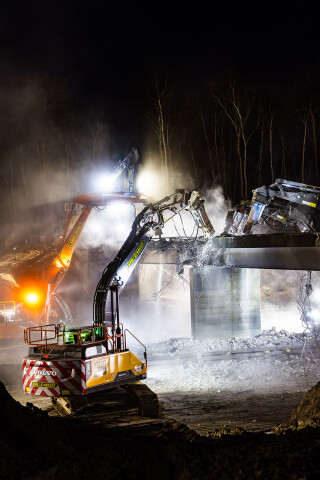“M25 closed for first time in history – shock!” – or words to that effect. Such was the reaction to the weekend closure of part of London’s orbital motorway in March that several national newspapers gave the story front-page prominence.
Anybody who has travelled regularly on the M25 knows that this was not the first closure in the road’s 38-year history, nor even the most significant disruption for its users. Accidents and sheer weight of traffic have made the M25 the road that drivers love to hate.
Rather, this was the first-ever planned closure, the reason being the need to demolish a bridge spanning the motorway at Junction 10. To do this, the motorway had to be closed between Junctions 10 and 11 from 9pm on Friday 15th March to 10pm on Sunday 17th March.
The M25 is notoriously congested and nowhere more so than at Junction 10, the A3 Wisley turn-off in Surrey. And for that reason National Highways is spending £317m improving the junction with new bridges and a modified layout.
“The reasons for the project are numerous,” says National Highways’ project lead Jonathan Wade. “But mainly it’s the number of collisions; traffic speeds are high and the junction has the worst casualty rate of any junction on the M25”.
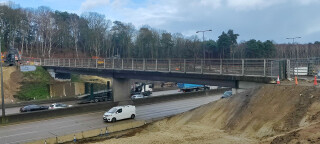
The junction simply cannot handle today’s volume of traffic, explains Wade, and the roundabout at the centre of the junction is now too small. That will be opened up, effectively pushing the junction’s slip-roads back some distance in either direction.
At the same time, new roads and bridges will take some of the traffic off local roads and new bridges will for the first time connect each of the four land quadrants previously divided by the intersection of the motorway and the A3.
The M25 itself will be widened at the junction from three lanes to four in both directions and the A3 will increase to four lanes either side of the roundabout.
Eight new bridges are being built (one, Stratford Brook, for Surrey County Council and not on the trunk road network, has already been built) and five bridges will be demolished. It was the third of these bridge demolitions that closed the motorway in March.
Main contractor Balfour Beatty was given the green light to start work in May 2022. The demolition contractor is Suffolk-based Clarke Demolition Company – now part of plant and transport group Tru7 (see box, p37).
“We were engaged by Balfour Beatty at ECI [early contractor involvement] stage about four years ago,” says Tru7 Demolition’s executive director David Clarke. “ECI is the standard these days – tier-one contractors are beginning to realise that we do know what we’re talking about.
“However the [demolition] contract was put out to tender in 2022. Having us involved early gave the client confidence to employ us – but of course, being a public sector contract, they had to get best value,” adds Clarke.
Tru7’s contract is for the five bridge demolitions; two over the A3 and three over the M25 itself. The two A3 bridges – the Wisley Lane footbridge and the Cockcrow bridleway bridge – have already been demolished.
Balfour Beatty will replace both of these bridges; Wisley Lane provides access to the Royal Horticultural Society’s RHS Garden Wisley and the new Cockcrow Bridge, a post-tensioned concrete structure, will be the UK’s first ‘green bridge’ – a 25m-wide heathland corridor to re-connect Ockham Common and Wisley Common which have long been separated by the A3.
The first M25 bridge for demolition – the one that closed the motorway in March – was Clearmount bridge, a two-span bridge with a central pier that carried a bridleway over the M25 west of Junction 10.
This had to be removed to make way for the re-designed road layout. The new design elongates the junction, effectively pushing the slip roads further back. This means that the slip roads will now extend beyond the point at which Clearmount bridge spanned the road, effectively widening both carriageways at that point.
Hence Clearmount bridge and its concrete abutments had to go. A new crossing, comprising a single-span steel bridge will now be built further back to replace the old bridge.
This will be a single-span steel arch bridge fabricated by Kent-based Nusteel Structures, which is fabricating all the steelwork for this project. The new Clearmount bridge will be assembled alongside the motorway and carried into place by specialist heavy transport company Mammoet using one of its self-propelled modular transporters.
While Tru7 Demolition was breaking out the old Clearmount bridge, Balfour Beatty took advantage of the road closure to install a new ‘superspan’ steel gantry (also fabricated by Nusteel) across the motorway nearby.
Weighing in at 128 tonnes, this gantry is the heaviest on the network, says Jonathan Ward. Delivered to site in two pieces, it was assembled alongside the motorway and lifted into position in one piece by a 750-tonne capacity mobile crane.
It is one of nine new superspan gantries to be installed on this project. Four of them will be over the M25 and the other five will span the A3 either side of the motorway. The new superspan gantries are designed to allow access for maintenance without the need to close one lane – which is a necessary expedient with the current designs.
The old Clearmount bridleway bridge comprised a cast-insitu concrete deck on steel beams. Its demolition was a relatively straightforward process involving breaking the deck onto the road and then cutting out the steel beams.
To prevent damage to the motorway’s concrete surface, Tru7 Demolition placed a protective platform cof 5m x 1m x 150mm timber bog mats under the bridge and out to 15m on either side. “This protected the road from the falling rubble and also from the heavy machinery doing the work,” says Clarke.
Tru7 cut the steel beams into 17m-long sections that were then lifted out by crane and cut into smaller lengths by hand.
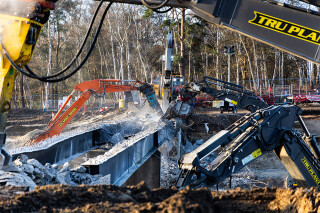
“It was the cleanest way of cutting them up,” says Clarke. “We looked at the option of munching away with excavator-mounted shears, which might have been quicker, but this was a cleaner and more controllable solution.”
Once the deck and beams were removed, Tru7 broke out the concrete abutments.
The design of the bridge meant that the central supporting pier sat over the concrete crash barrier that separates the two carriageways. The pier was demolished down to the top of the barrier, which was then made good.
The barrier itself could not be broken out and so it remained in place, dividing the jobsite right down the middle. Clearing it to provide space for the demolition plant to manoeuvre would have entailed breaking out a considerable length either side of the bridge and then reinstating it, a process that would have delayed completion of the job.

“We couldn’t demolish the central barrier, and therefore we couldn’t move from one side of the motorway to the other. Essentially we were doing two bridge demolitions side-by-side,” says Clarke.
This meant a duplication of effort and equipment. On either side of the barrier, Tru7 mobilised two telehandlers, two 45-tonne excavators, one 60-tonne excavator, one 25-tonne wheeled excavator with a grab for handling the debris and two 30-tonne articulated dump trucks.
Tru7 deployed 14 people working three 12-hour shifts to complete the demolition of Clearmount bridge. They finished the task a full six hours ahead of programme, allowing National Highways to reopen the motorway on the Sunday evening, eight hours ahead of the scheduled deadline of 6am on Monday 18th March.
“Looking back, we probably could have saved another one or two hours,” says Clarke. “We were confident that we could do it in the time available – it wasn’t a technically challenging task. The main challenge arose from the significance of the job and all the media attention focused on it. I’m told that the deputy prime minister [Oliver Dowden] wanted to be involved and was getting regular updates on progress.”
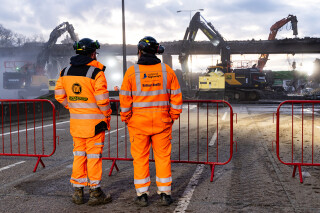
Such high-level scrutiny added to the pressure: “All eyes were on us,” he adds.
Nevertheless, this kind of contract is familiar territory for Tru7 Demolition since it is an acknowledged bridge demolition specialist.
“We’ve done over 200 bridges in the UK, starting in the early 1980s with the electrification of the London-to-Norwich rail line. We demolished 26 bridges on that project,” says Clarke.
“Then we did 12 bridges on the CTRL [Channel Tunnel Rail Link, aka High Speed 1] including one bridge we’d already demolished once before!” he adds.
Bridge demolition is not especially tricky from a technical viewpoint, Clarke admits. “It’s pretty straightforward; but a lot of non-specialists underestimate the amount of preparation and clearing up afterwards,” he says. An inexperienced contractor can easily come unstuck on such a job where significant penalties apply if the road or railway is not reopened by the agreed deadline.
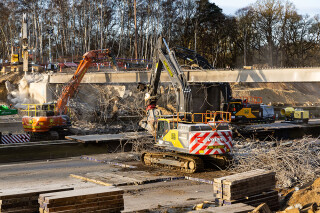
There now remain two bridges for Tru7 to demolish at Junction 10: the northern and southern gyratory bridges over the M25 either side of the main roundabout. These are being replaced by new bridges located further apart to accommodate the elongated junction layout.
“We can’t knock those down until Balfour Beatty has built the new roundabout bridges later this year,” says Clarke. Once again, this will require a full closure of the motorway – and they are much more substantial structures than Clearmount bridge.
“These are about 3,500 tonnes of concrete each. We won’t be doing them in one weekend,” Clarke says. “They will be demolished in two possessions up to four weeks apart.”
But first there will be other closures. The next one is planned for the weekend of 10th-13th May when Balfour Beatty will lift into place the 72 concrete beams (68 weighing 16 tonnes and four weighing 40 tonnes) for the new southern gyratory bridge.
Again, the contractor will install another superspan gantry at the same time.
Then in late summer, at a date yet to be decided, Balfour Beatty will repeat this operation for the northern gyratory bridge, lifting the beams into place and installing the associated gantry. Only when these two bridges are completed and traffic diverted onto them can Tru7 start preparing to demolish the original gyratory bridges.
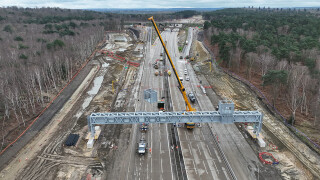
“That’s still some way down the road,” says Wade.
Tru to form
Tru7 Demolition – previously Clarke Demolition Company (CDC) – became part of Tru7 Group in 2017 when owner David Clarke (above) sold the business to neighbour and family friend Guy Nicholls.
The two families have been close for decades: “I’ve known Guy nearly all my life; our parents were friends and we’ve always been close,” says Clarke.
Clarke was the second generation owner of CDC, the business founded by his father in 1954. Nicholls had also inherited his father’s business, founded in the mid-1960s.
That business was Fork Rent, which after his father’s death in 1997, Guy Nicholls built into one of the UK’s biggest independent plant hire firms before selling it to former Speedy Hire boss Steve Corcoran in 2015.
Corcoran also bought out London-based One-Call Hire and, combining the two, created Ardent Hire Solutions.
Two-and-a-half years after selling Fork Rent, having complied with a non-compete clause, Nicholls set up a new plant hire business, initially made up of two divisions – Trucks ‘R’ Us and Tippers ‘R’ Us, or Tru7 Group for short.
“Seven is my lucky number,” says Nicholls. “I’m weirdly superstitious about it.”
After Clarke became ill with cancer in 2014, he decided to start looking for a buyer for CDC. “I’ve got two daughters who, I’m glad to say, aren’t at all interested in demolition,” he says. But Nicholls, who had rallied round to provide support to his old friend during his recovery from treatment, was definitely interested.
So it seemed the most natural thing for Clarke to sell the business to Nicholls: CDC became Tru7 Demolition. Clarke still oversees the demolition division and will continue to do so for the foreseeable future. “It’s a ‘planned absorption’,” he says. “Guy’s told me I’m not allowed to retire yet.”
Got a story? Email news@theconstructionindex.co.uk


